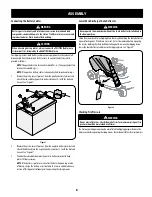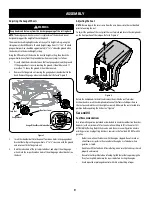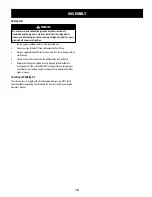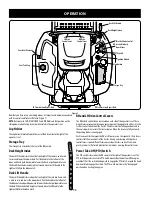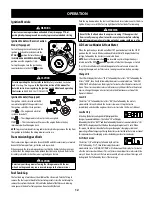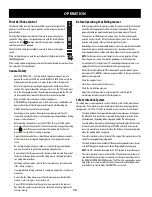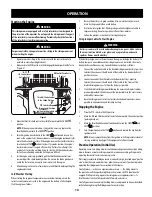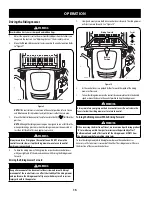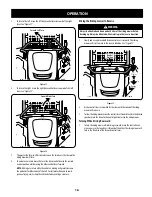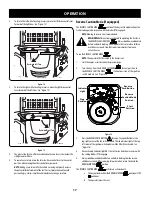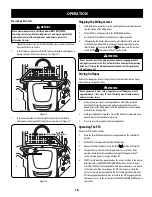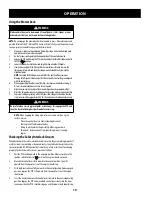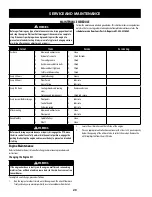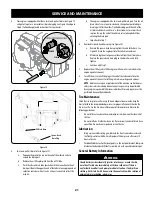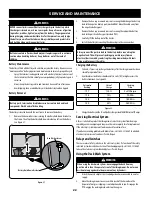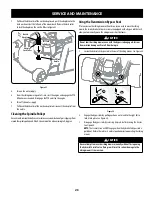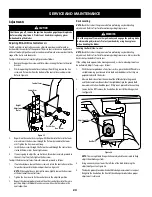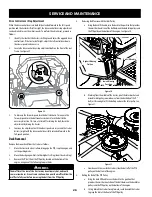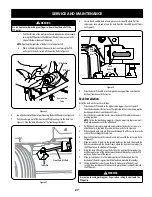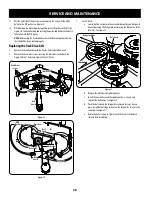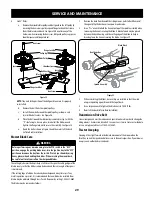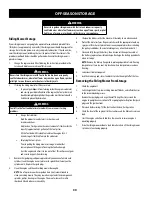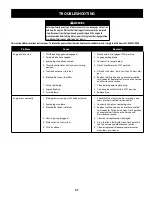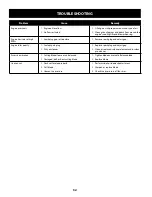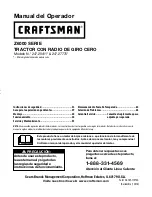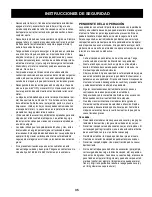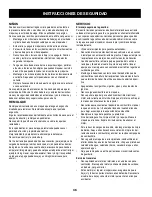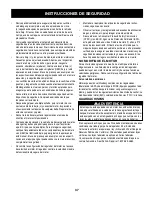
22
SERVICE AND MAINTENANCE
WARNING
NEVER connect (or disconnect) battery charger clips to the battery while
the charger is turned on, as it can cause sparks. Keep all sources of ignition
(cigarettes, matches, lighters) away from the battery. The gas generated
during charging can be combustible. As a further precaution, only charge
the battery in a well ventilated area. Always shield eyes and protect skin
and clothing when working near batteries.
WARNING
Batteries contain sulfuric acid and may emit explosive gases. Use extreme
caution when handling batteries. Keep batteries out of the reach of
children.
Battery Maintenance
The battery is filled with battery acid and then sealed at the factory. However, even a
“maintenance free” battery requires some maintenance to ensure its proper life cycle.
•
Spray the terminals and exposed wire with a battery terminal sealer, or coat
the terminals with a thin coat of grease or petroleum jelly, to protect against
corrosion.
•
Always keep the battery cables and terminals clean and free of corrosion.
•
Avoid tipping. Even a sealed battery will leak electrolyte when tipped.
Battery Removal
WARNING
Battery posts, terminals and related accessories contain lead and lead
compounds. Wash hands after handling.
The battery is located beneath the seat frame. To remove the battery:
1.
Remove the hex washer screw securing the battery hold-down bracket to
the frame. Then flip the battery hold-down bracket up to free the battery.
See Figure 21.
Hex Washer Screw
Battery Hold-Down Bracket
Figure 21
2.
Remove the hex cap screw and sems nut securing the black negative battery
lead to the negative battery post (marked NEG). Move the cable away from
the negative battery post.
3.
Remove the hex cap screw and sems nut securing the red positive battery
lead to the positive battery post (marked POS).
4.
Carefully lift the battery out of the tractor.
5.
Install the battery by repeating the above steps in the reverse order.
WARNING
Always connect the positive lead to the battery before connecting the
negative lead. This will prevent sparking or possible injury from an
electrical short caused by contacting the riding mower body with tools
being used to connect the cables.
Charging the Battery
1.
Test and, if necessary, recharge the battery after the riding mower has been
stored for a period of time.
2.
A voltmeter or load tester should read 12.6 volts (DC) or higher across the
battery terminals. See Figure 22.
Voltmeter
Reading
State of
Charge
Charging
Time
12.7
100%
Full Charge
12.4
75%
90 Min.
12.2
50%
180 Min.
12.0
25%
280 Min.
Figure 22
3.
Charge the battery with a 12-volt battery charger at a MAXIMUM rate of 10 amps.
Servicing Electrical System
A fuse is installed to protect the riding mower’s electrical system from damage
caused by excessive amperage. Always use the same capacity fuse for replacement.
If the electrical system does not function, check for a blown fuse.
If you have a recurring problem with blown fuses, call 1-888-331-4569 to schedule
electrical system service from Sears Parts & Repair.
Relays and Switches
There are several safety switches in the electrical system. If a function of the safety
interlock system described earlier is not functioning properly, call 1-888-331-4569
to have the electrical system checked by Sears Parts & Repair.
Using the Deck Wash System
WARNING
When using the deck wash system, never engage the deck from any
position other than the operator’s seat of the riding mower. Do not use an
assistant or engage deck in the presence of any bystanders.
1.
Attach the nozzle adapter to a standard garden hose connected to a water
supply.
2.
Move the riding mower to an area within reach of the hose where the
dispersal of wet grass clippings is not objectionable to you. Disengage the
PTO, engage the parking brake, and stop the engine.
Summary of Contents for 247.20411 SERIES
Page 67: ...NOTAS 67 ...
Page 68: ...NOTAS 68 ...

